Phillies All-Decade Team 1970s: Homegrown Talent at the Forefront


The Phillies began to bud into a contender in the 1970’s thanks to some tremendous homegrown talent
The 1970s started out poorly for the Phillies, finishing fifth or sixth each of the first four seasons. However, the acquisition of Steve Carlton in 1972 and homegrown talent of Bob Boone, Larry Bowa, Larry Christenson, Greg Luzinski, and Mike Schmidt paved the way for the first great era of Phillies baseball in franchise history.
Let’s take a look at the Phillies all-decade team for the 1970s.
Deron Johnson
Johnson played for four different teams over his first eight Major League seasons before being sold by the Braves to the Phillies on December 3, 1968. After 17 home runs and 80 RBI in 1969, Johnson two of the best seasons to follow.
In 1970, Johnson earned some MVP consideration after hitting .256 with 28 doubles, 27 home runs, and 93 RBI. Outdoing himself in 1971, Johnson belted a career-best 34 home runs, 29 doubles, and 95 RBI, while hitting a solid .265.
Still hitting for a decent amount of power as a platoon player in 1972, Johnson’s average dipped to .217. After hitting just .167 in 44 at-bats, he was traded to the Oakland A’s on May 2, 1973 in exchange for Jack Bastable.
During his time in Philadelphia, Johnson posted a batting average of .251 with 82 doubles, 88 home runs, and 304 RBI. In 16 Major League season with seven different teams, Johnson hit .254 with 1066 hits, 186 home runs, and 680 RBI.
Honorable mention: Rich Hebner
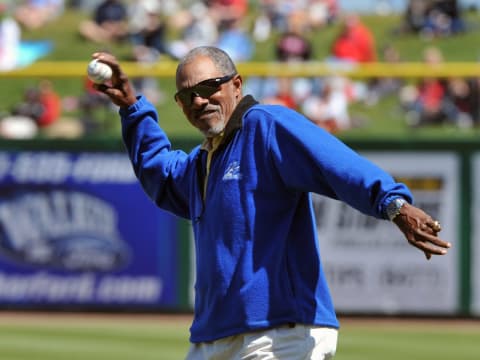
Dave Cash
Cash was on the verge of stardom during his first four years in the Major Leagues with the Pittsburgh Pirates. The Phillies acquired Cash via trade with the Pirates for Ken Brett on October 18, 1973.
The best three seasons of his career were all in a Phillies uniform. in 1974, hit .300 with 26 doubles, 11 triples, 58 RBI, 20 stolen bases, and led the league in at-bats with 687. He was also above average defensively with a .977 fielding percentage, four points above the league average. Cash’s efforts earned him his first All-Star appearance.
Cash had the best season of his career in 1975, leading the league in hits with 213, had 40 doubles, 111 runs scored, 50 RBI, and a .305 batting average. He made his second All-Star team and followed that up in 1976 with a .284 average, a league-best 12 triples, 56 RBI, and only 16 strikeouts in 666 at-bats.
Cash was granted free agency in November of 1976 and went on to play for the Expos for three seasons and the Padres for one before retiring.
Although his time in Philadelphia was relatively short, Cash made the most of it, hitting .296 with 608 hits, 80 doubles, and 26 triples. His range factor and fielding percentage were above the league average, making him a dual-threat and best second baseman for the Phillies in the 1970s.
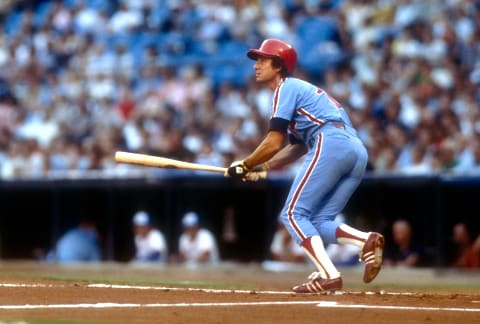
Larry Bowa
Bowa began is Major League career as a 24-year old in 1970. He hit .250 with 17 doubles, 34 RBI and 20 stolen bases. Not impressive offensively, Bowa dazzled with his defense, committing just 13 errors with a .979 fielding percentage. His efforts earned him third-place votes for Rookie of the Year.
In 1972, Bowa led the National League with 13 triples and earned his first Gold Glove Award, committing just nine errors with a fielding percentage of .987, a full 20 points above the league average. The following season was a down year for Bowa, hitting just .211 with an anemic .249 s slugging percentage.
Bowa had his finest stretch from 1974 through 1979, making the NL All-Star team five seasons. He had 10 triples, 39 stolen bases and a .285 average in 1974, and a career-high .305 batting average in 1975.
In 1976, Bowa swiped 30 bases for the second time in his career and had a career-high 49 RBI. Bowa failed to make the All-Star team in 1977, but was still rock solid on defense with a .983 fielding percentage and hit four home runs, his highest single-season output.
The 1978 season was perhaps the best of Bowa’s career. He hit .294 with 31 doubles, 24 stolen bases, and a .986 fielding percentage. He was named All-Star, Gold Glove Award winner and third in the NL MVP vote.
Bowa finished the 1970s with his final All-Star appearance and failed to win the Gold Glove Award, despite committing only six errors with a stellar .991 fielding percentage.
After playing two more seasons in Philadelphia, Bowa was traded along with Ryne Sandberg to the Cubs for Ivan DeJesus.
Bowa goes down as the top shortstop of the 1970s and second-best shortstop in Phillies history.

Mike Schmidt
There’s clearly no doubting that the greatest player in Phillies history and the greatest third baseman of all-time makes this list.
Schmidt’s career started very slowly, going 7-for-34 with 15 strikeouts in 1972 and hitting only .196 with 18 home runs and 136 strikeouts his rookie campaign. Things began to click for Schmidt in 1974, leading the league in home runs with 36, to go along with 116 RBI.
Schmidt paced the National League in home runs in 1975 and 1976, hitting 38 each season. He made his second All-Star team in 1976, won his first Gold Glove Award and finished third in the MVP voting.
After another 38 home run season in 1977 with another Gold Glove Award and All-Start to his resume, Schmidt struggled in 1978. His home run total dropped to 21, which would be only season from 1974 through 1987 that he failed to hit at least 30 home runs. Despite the offensive woes, Schmidt earned another of his ten career Gold Glove Awards.
As all stars do, they rebound from subpar seasons. Schmidt more than doubled his home run output in 1979, smashing 45 with 114 RBI and a league-high 120 walks. Schmidt was just entering his prime and dominated offensively for much of the next eight seasons.
Schmidt hit 235 home runs during the decade with 666 RBI, four All-Star appearances and four Gold Glove Awards.
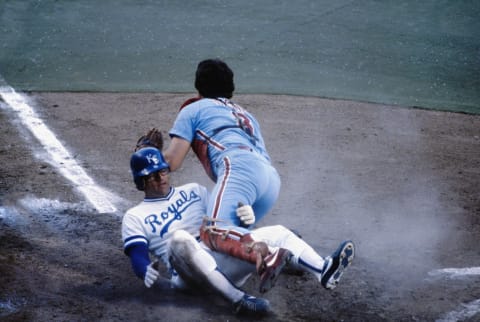
Bob Boone
Boone was called up by the Phillies in 1972, going 14-or-57 with a home run in 16 games. He flourished as a rookie in 1973, batting .261 with 20 doubles, 11 home runs, and 61 RBI, finishing third in Rookie of the Year voting.
After two solid seasons in 1974 and 1975, Boone made his first All-Star team in 1976 when he hit .271 with four home runs and 54 RBI. He was among the best defensively in the league, committing just four errors for a .993 fielding percentage.
Known more for his defensive ability, Boone had his two most productive offensive seasons in 1977 and 1978, hitting a combined .284 with 44 doubles, eight triples, 23 home runs, and 128 RBI. He was recognized for his efforts in 1978 with his first Gold Glove Award and second All-Star appearance.
Boone repeated at an All-Star and Gold Glove Award winner in 1979 after posting a .286 average, his highest in a Phillies uniform. He threw out 44 percent of would-be base stealers, well above the league average of 34 percent.
Boone’s tenure with the Phillies ended following the 1981 season when he was sold to the California Angels. During the 1970s Boone hit .268 with 788 hits, 142 doubles, and 52 home runs to go along with two Gold Glove Awards.
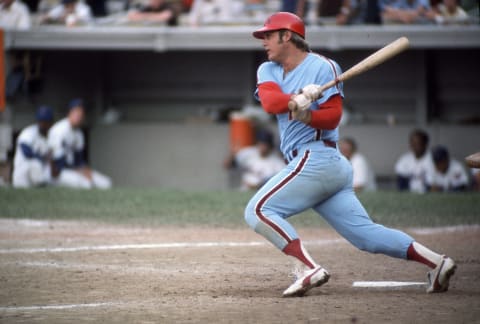
Greg Luzinski
Luzinski made his Major League debut as a 19-year old in 1970, going 2-for-12 with five strikeouts. After three home runs in 28 games the following season, Luzinski played his first full season and hit .281 with 33 doubles and 18 home runs.
Known as “The Bull”, Luzinski launched 29 home runs with 97 RBI, while hitting .285. After playing in only 85 games in 1974 with seven home runs, Luzinski started a run of three consecutive .300 plus seasons. He hit 34 home runs with a league-high 120 RBI and finished second in the MVP voting.
In 1976, Luzinski’s home run production dropped to 21, but still knocked in 95 and hit .305. His best overall season in the Major Leagues was in 1977 when he went deep 39 times with 130 RBI and a .309 batting average. Luzinski made his third of four straight All-Star appearances and finished second to Dave Parker in the MVP vote.
Luzinski posted his final 30-plus home run season with the Phillies in 1978, hitting 35 with 101 RBI. His production declined significantly to 18 home runs and a .252 average in 1979. After the World Series campaign of 1980, Luzinski was sold to the White Sox before the beginning of the 1981 season.
In 1283 games for the Phillies during the 1970s, Luzinski hit 204 home runs with 755 RBI.
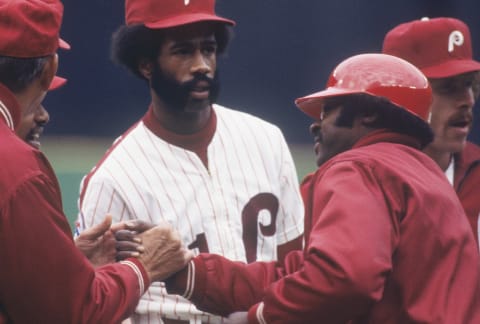
Garry Maddox
Maddox was a 25-year old when the Phillies acquired him in a trade with the Giants for Willie Montanez on May 4, 1975. Maddox paid immediate dividends, hitting .291 with 25 doubles and 24 stolen bases in 99 games.
The 1976 campaign was probably the best overall season for Maddox at the plate. He hit .330 with 37 doubles, 68 RBI, and 29 stolen bases. He finished fifth for NL MVP and won his second of eight consecutive Gold Glove Awards.
Maddox had a bit of a power surge in 1977, hitting 27 doubles, 10 triples, 14 home run, and 74 RBI, and 22 stolen bases, while hitting .292. He continued his consistent bat, hitting above .280 for both 1978 and 1979 with a combined 62 doubles, 24 home runs, and 59 stolen bases.
From 1975 through 1979 Maddox had 42 outfield assists and just 29 errors. His 1979 season of two errors and .991 fielding percentage was the best of his career.
Maddox played for the Phillies into the first part of the 1986 season before retiring. The best defensive outfielder in franchise history is a shoo-in for the 1970s All-Decade Team.
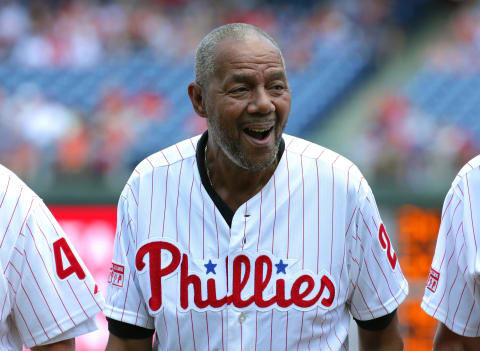
Bake McBride
McBride was traded by the St. Louis Cardinals, along with Steve Waterbury to the Phillies on June 15, 1977 for Dane Iorg, Tom Underwood, and Rick Bosetti. He brought to Philadelphia a solid resume which included four-plus straight .300 batting average seasons and Rookie of the Year.
He continued the stellar offense in 85 games with the Phillies in 1977, hitting .339 with 20 doubles, 11 home runs, 41 RBI, and 27 stolen bases. The following season, McBride’s batting average dropped significantly to .269 but still had 20 doubles and 28 stolen bases.
The 1979 season saw McBride reach double digits in doubles, triples, home runs, and stolen bases, while hitting .280. Despite playing outstanding defense, committing only seven errors in 339 games, McBride never received a Gold Glove Award.
McBride went on to play for the Phillies through the 1981 season before finishing his career with the Cleveland Indians, knee-injuries forcing retirement at the age of 34.
In five seasons with the Phillies, McBride hit .292 with 616 hits, 106 doubles, 44 home runs, and 98 stolen bases.
Honorable mention: Willie Montanez
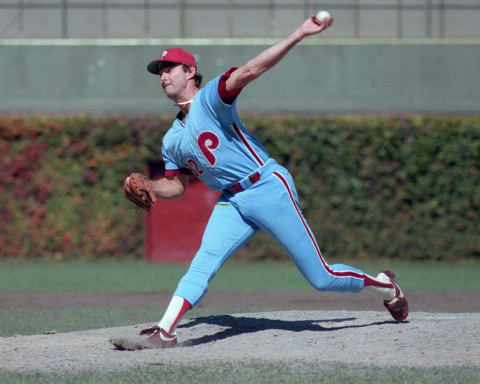
Steve Carlton
When the Phillies traded Rick Wise for Steve Carlton on February 25, 1972, little they’d know at the time that the newly acquired lefthander would become the greatest pitcher in franchise history.
The 27-year old Carlton was coming off his third All-Star season entering the 1972 season. On a terrible Phillies team that won just 59 games, Carlton put together one of the best seasons by a starting pitcher in the modern era. He went 27-10 with a 1.97 ERA, completing 30 games, eight shutouts, 346 1/3 innings, and 310 strikeouts. The season earned Carlton the Cy Young Award and fifth in the MVP vote.
Carlton dropped to 13-20 the following season, although he led the league in complete games and innings pitched. In 1974, Carlton won 16 with a 3.22 ERA and led the National League in strikeouts with 240.
After a 15-14 campaign in 1975, Carlton notched his second 20-win season with the Phillies in 1976, leading the league with a .741 winning percentage. He recorded back-to-back 20-plus win seasons in 1977, after going 23-10 with 198 strikeouts and a 2.64 ERA. That was good enough for Carlton to earn his second Cy Young Award.
Carlton closed out the 1970s with his fourth All-Star appearance with the Phillies and his fifth career season with at least 200 strikeouts. In eight seasons with the Phillies in the 1970s, Carlton posted a record of 148-98 with 1732 strikeouts and an ERA of 3.07.

Jim Lonborg
Lonborg was an eight-year veteran when the Phillies acquired him along with Ken Sanders, Ken Brett, and Earl Stephenson for John Vukovich, Bill Champion, and Don Money on October 31, 1972.
In his first season with the Phillies, Lonborg went 13-16 with a 4.66 ERA. He proceeded to win 17 in 1974 with 16 complete games and 283 innings pitched. Lonborg’s 1975 season was limited to 27 games, compiling an 8-6 record with a 4.12 ERA.
Lonborg’s best overall season with the Phillies and best since he went 22-9 for the 1967 Red Sox was in 1976. In 32 starts, he went 18-10 with eight complete games with one shutout. His 3.08 ERA was lowest of his career and his 222 innings pitched was fourth-most.
At the age of 35 in 1977, Lonborg’s production started to decline, but he still managed an 11-7 mark in 25 games with a decent ERA of 4.11. Clearly near the end during the 1978 season, Lonborg went 8-10 with his ERA above five for the first time in his career.
Lonborg was released by the Phillies on June 16, 1979 after going 0-1 with an 11.05 ERA in four games. He never pitched another game in the Major Leagues, retiring with 157 wins and a 3.86 ERA.
During his time in Philadelphia, Lonborg posted a respectable 75-60 record with an ERA of 3.98.
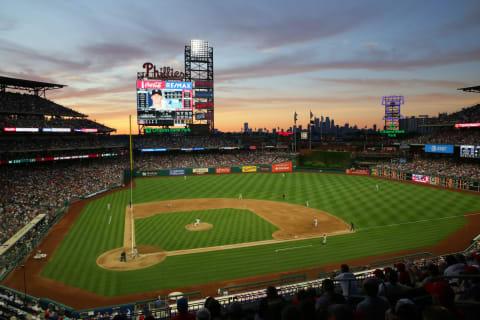
Dick Ruthven
The Phillies selected Ruthven in the first round of the 1973 draft out of California State University Fresno. He made his Major League debut on April 17, 1973 and went on to post a 6-9 record with a 4.21 ERA in 23 starts.
Ruthven logged 212 2/3 innings in 1974 and posted what proved to be a career-high 153 strikeouts. He spent time in the Phillies AAA affiliate in 1975 winning 10 with an ERA of 3.18 and went 2-2 with the Phillies with an ERA of 4.20 in 11 games.
On December 10, 1975, Ruthven was traded to the White Sox along with Roy Thomas and Alan Bannister for Jim Kaat and Mike Buskey. He returned to the Phillies in June 1978 in exchange for reliever Gene Garber.
Ruthven did not disappoint in his return to the Phillies, going 13-5 with a 2.99 ERA in 20 starts. The 1979 season was limited to 20 starts, but he still finished with a winning record of 7-5 despite a subpar ERA of 4.22.
A big part of the rotation for the 1980 World Series winning team, Ruthven went on to pitch for the Phillies through part of the 1983 season.
All told, Ruthven compiled a 37-34 record for the Phillies in the 1970s with an ERA of 3.87.
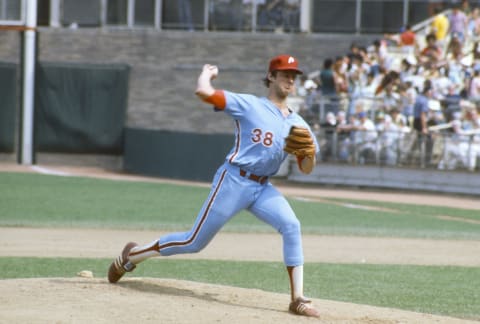
Larry Christenson
Christenson was drafted by the Phillies in the first round out of high school in 1972. He made his Major League debut as a 19-year old the following April. He went 2-5 with an ERA over five for the Phillies in 20 games combined in 1973 and 1974.
The following year, Christenson showed real promise, winning 11 of 17 decisions with an ERA of 3.67 in 171 2/3 innings. He continued his ascension with a 13-win season in 176 with an ERA of 3.68 in 168 2/3 innings.
The next two seasons saw Christenson put it all together, on the verge of All-Star status. In 1977 he went 19-6 with a 4.06 ERA in 219 1/3 innings. He followed that with career highs in strikeouts (131) and innings (228) in 1978 to go along with 13 wins and a 3.24 ERA.
Injuries began to take their toll on Christenson, limiting him to 19 games in 1979 and a poor 5-10 record with an ERA of 4.50.
Sadly, Christenson was never able to shake the injury-bug, pitching in just 34 games over the next two seasons. He had one last hurrah in 1982, logging 223 innings with a new career high in strikeouts and an ERA of 3.47.
Christenson retired with an 83-71 record with an ERA of 3.79 in 243 games.
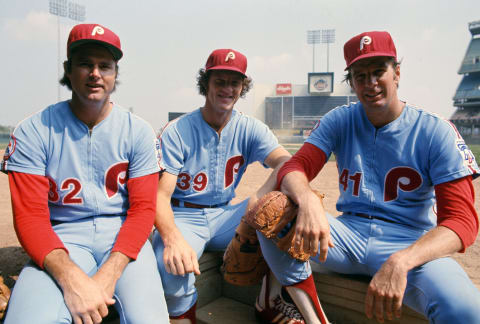
Jim Kaat
Kaat was a three-time All-Star and 17-year Major League veteran when Phillies acquired him in a trade with Mike Buskey for Dick Ruthven, Alan Bannister, and Roy Thomas in December of 1975.

A solid back end of the rotation starter for the NL East champions in 1976, Kaat went 12-14 with an ERA of 3.48. In 38 games (35 as a starter), Kaat completed seven with one shutout in 227 2/3 innings.
Kaat struggled in 1977 as his record dropped to 6-11 with a 5.39 ERA in 35 games and 160 1/3 innings. As a 39-year old, he had a rebound season of sorts in 1978, winning eight and dropping only five with an ERA just over four.
After a 1-0 start in four games for the Phillies in 1979, Kaat was sold to the New York Yankees on May 11. Kaat ended up pitching for the Yankees and Cardinals for a few more years before retiring in 1983 at the age of 44.
Kaat had a relatively mediocre 27-30 record with an ERA of 4.23 in 102 games with the Phillies. However, he provided stability to the staff during three consecutive NL East title teams.
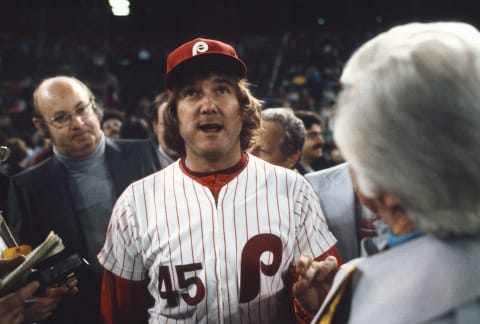
Tug McGraw
McGraw is best known in Philadelphia for his work during the 1980 season, particularly late and in the postseason. However, he did much more during his long tenure in Philadelphia which began he was traded to the Phillies by the Mets in December of 1974.
More from That Balls Outta Here
- Prospect Andrew Baker could help Phillies bullpen in 2023
- Bryce Harper’s absence should lead to Phillies lineup tinkering
- Phillies rumors: Club targets Seth Lugo for possible bullpen role
- Pirates’ bizarre Vince Velasquez hype video will make Phillies fans laugh
- Acquiring Brandon Marsh gave the Phillies flexibility
In 1975, McGraw made his second and final All-Star team, going 9-6 with 14 saves and a 2.96 ERA in 102 2/3 innings. A model of consistency, McGraw logged 97 1/3 innings the next season, won seven, saved 11 and had a fine ERA of 2.50.
Although appearing in only 45 games in 1977, McGraw went 7-3 with nine saves and an ERA again under three, at 2.62. He allowed only 62 hits in 79 innings while striking out 58.
The 1978 season saw McGraw’s ERA on the high side of three for the first time in Philadelphia, at 3.21. He was still quite effective, winning eight and saving nine in 55 games.
McGraw’s 1979 season was a blip on the radar, posting a career worse 5.16 ERA for a full season, although he still saved 16 games and compiled 83 2/3 innings. The “Tugger” went on to pitch five more seasons with the Phillies, retiring after the 1984 season at the age of 39.
During the 1970s with the Phillies McGraw went 35-25 with 59 saves and an ERA of 3.26.
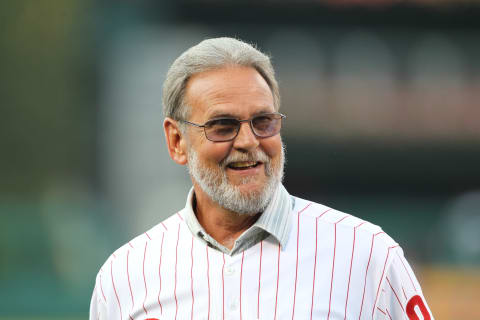
Gene Garber
Garber, a Lancaster, PA native, was in his fifth Major League season when he was sold to the Phillies from the Kansas City Royals on July 12, 1974. He became a mainstay in the Phillies bullpen for the next few seasons.
More from Phillies All-Time Lists
- Every first-round draft pick in Philadelphia Phillies history
- Every number retired by the Philadelphia Phillies
- The most legendary Phillies third basemen of all time
- Top single-season performances by righties in Phillies history
- These are the Phillies’ biggest first-round draft busts
In 1974, Garber 4-0 with four saves and a 2.06 ERA in 34 games. He was the workhorse out of the pen in 1975, leading the league in appearances with 71 and games finished with 47. Garber won 10, saved 14 and had an ERA of 3.60 in 110 innings.
Garber continued to log a lot of innings in relief, throwing 92 2/3 in 1976 and 103 1/3 in 1977. During those seasons, his record was a combined 17-9 with 30 saves and an ERA of 2.57. Garber continued his dominance in 1978, posting an ERA of 1.40 in 22 games before being traded for Dick Ruthven on June 15.
Garber went on to pitch 11 more seasons with the Braves and Royals before retiring in 1988. During his time in Philadelphia, Garber posted a 33-22 record with 51 saves and a 2.68 ERA.
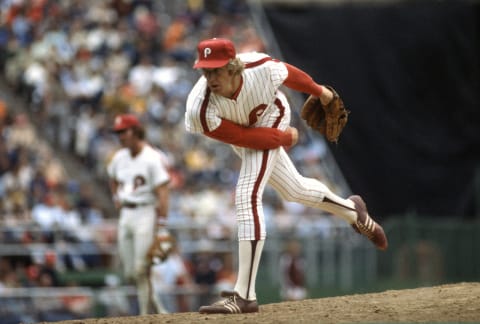
Ron Reed
Reed played two seasons in the NBA with the Detroit Pistons before going to baseball fulltime in 1968. Reed was in his eighth full Major League season when the Phillies acquired him from the St. Louis Cardinals for Mike Anderson on December 9, 1975.
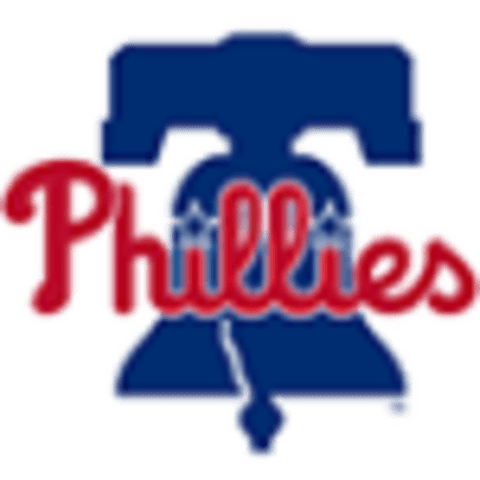
Philadelphia Phillies
In his first season with the Phillies in 1976, Reed won eight and saved 14 with an ERA of 2.46 in 128 innings. Reed continued to be a rubber arm out of the pen in 1977, going 7-5 with 15 saves in 60 games with an ERA of 2.75 in 124 1/3 innings.
The amazing run for Reed continued for the 1978 season, in which he saved a career-high 17 games with a slim 2.24 ERA. He allowed just 87 hits in 108 2/3 innings over 66 games.
Reed won 13 of 21 decisions in 1979, but posted his higher ERA in eight years with the Phillies at 4.15. But he will still extremely durable, working another 100+ innings out of relief for the fourth consecutive season.
After several more successful seasons with the Phillies, Reed was traded to the White Sox for Jerry Koosman on December 5, 1983.
In 246 games for the Phillies during the 1970s, Reed compiled a record of 31-24 with 51 saves and an ERA of 2.86.